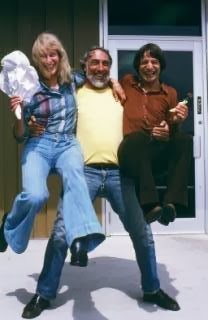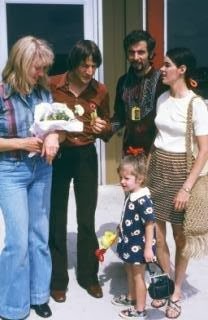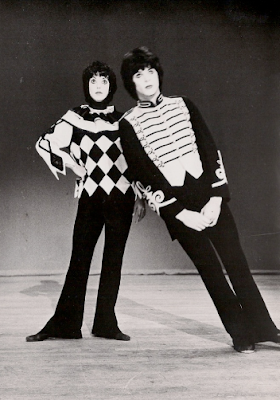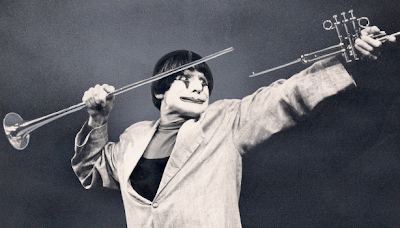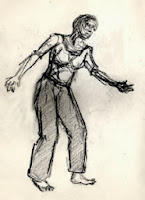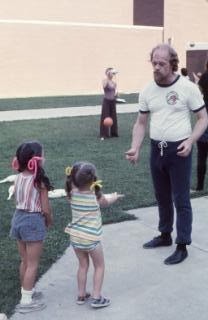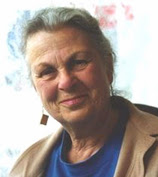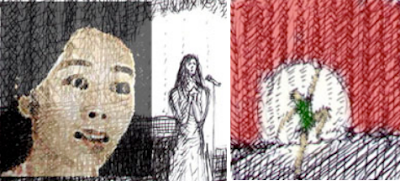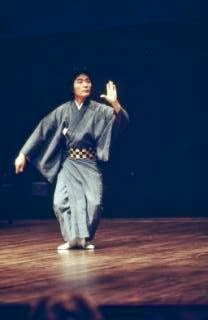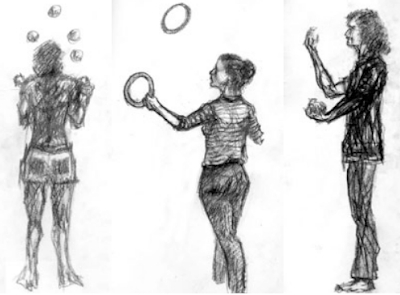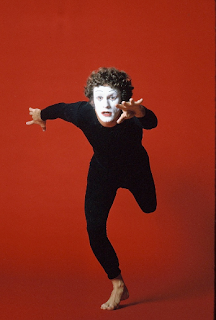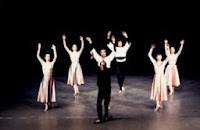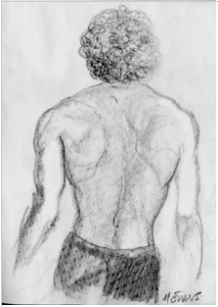[post 339]The 1974 International Mime Institute & Festival
Viterbo College, La Crosse, Wisconsin
A History by Jef Lambdin
![]() |
Carlo Mazzone-Clementi gives his support
to Dimitri and Dimitri's wife Gunda
Photo by Lou Campbell. |
In the summer of 1974, America was knee-deep in the Watergate Hearings; the World’s Fair was in Spokane, Washington; and John Denver was serenading us over the airwaves with “Sunshine on My Shoulder.” Amidst all of this, at a small Wisconsin college along the Mississippi River, there was a gathering of some 500 mime performers, teachers, students, news hounds, and townspeople: the
International Mime Institute and Festival.It was America’s first mime festival. Held on the campus of Viterbo College in La Crosse, Wisconsin, the event ran from July 20th to August 10th. Directed by Dr. Lou Campbell, the head of the theater department at the college, with the help of Program Coordinator Bari Rolfe, it set out to be a smorgasbord of experience in master classes and lecture-demonstrations, as well as a film series rounding out the mainstage festival performances. The festival was documented by articles in newspapers around the world, and also by a ten-page article in the January 1975 issue of
Smithsonian magazine.
![]() |
Top row: Lou Campbell, Hovey Burgess, William Burdick, and Laura Campbell. Bottom row: Judy Burgess with Lisa & Lucette Campbell.
From the author's collection. |
For $3.00 ($2.50 if you bought between six and twenty tickets) you could have seen the work of Dimitri from Switzerland;
Menagerie Mime Theatre from San Francisco; Mamako from Tokyo; Noel Parenti from San Francisco; Peter Franklin-White with members of the
Elmhurst Ballet School from Surrey, England; Ladislav Fialka and his
Theatre on the Balustrade from Prague; Carlo Mazzone-Clementi from California; Antonin Hodek also from California; Lotte Goslar and her
Pantomime Circus from New York; Robert Shields and Lorene Yarnell from San Francisco; the
Charles Weidman Dance Company from New York; Yass Hakoshima from Japan; Ctibor Turba from Prague; Samuel Avital from Israel and Colorado;
Mummenschanz from Switzerland; Geoffrey Buckley from England;
The Friends Roadshow from Michigan; and Pierre Byland and Philippe Gaulier, from Switzerland and France.
![]() |
The dormitory at Viterbo College. Photo by Mike Evans. |
Dr. Lou (Lou Campbell) and his staff created a “big tent” approach not only to the performances, but also to the workshops, lecture demonstrations, and master classes offered. You could have attended classes on such topics as Kabuki, mime, period dance and style, mask, self mask, mime focused for students in junior and senior high school, commedia dell’arte, dance, stage combat, clowning, and circus arts with the performers as well as with: William Burdick, Bari Rolfe, E. Reid Gilbert, Shozo Sato, Joram Boker, Jewel Walker, Tom Leabhart, Jango Edwards, Gary Parker, Jacques Lecoq, Hovey & Judy Burgess, and Louis Dezseran.
To get the full value of your tuition of $250 (plus room and board at the college dorm and cafeteria of $16.50/week) you could also attend student performances; go on a field trip to the Circus World Museum in Baraboo, Wisconsin; attend a
Tribute to Etienne Decroux, catch the outdoor performances of the Friends Roadshow; and attend the screenings of films such as
Les Enfants du Paradis,
Skaterdater, The Mime of Marcel Marceau, Clay Origins, Why Man Creates, Steamboat Bill Jr., Traffic, a Max Linder compendium, a Pierre Etaix compendium, a Dick Van Dyke compendium,
Cameos of Comedy, and
The Gold Rush.
As you can see, it was a very busy three weeks! People came from all over the world to perform, to teach, to share, to learn and to experience what the world of mime had to offer. Here are a few remembrances of the event from the viewpoints of individual teachers, performers and students who were there.
_____________________________________
Dr. Lou Campbellis the Executive Director and creator of Enclave of the Arts in Fort Worth, Texas. Enclave of the Arts is a professional, Christian-context, non-profit performing arts organization devoted to advancing the arts. In 1974, Dr. Lou was the Director of the International Mime Institute and Festival and the Chairman of the Theater Arts Department at Viterbo College in La Crosse, Wisconsin.
What was I thinking? I can tell you exactly and concisely what I was thinking. My fundamental reason for doing the festival was my investigation of
the gesture. It began back when I finished my master's degree, just an MA. I’d had all of the typical acting classes and at the master's level, of course, we were challenged and introduced to an understanding of Stanislavsky.
I then took my first job after receiving my Master's degree. I went to Emporia, Kansas, to what was then Kansas State Teachers College. I was hired as a designer/tech director, which was fine. As I was also wrestling with issues about performance I asked for and received permission to have a special projects, or independent study kind of thing on human body movement: stage movement. This was in 1967.
So at the beginning of the semester, I said to my students, “We’re going to go over to the library, and I want you to find any books that deal with human body movement that aren’t about technique: not tap dance, not ballet, not technique.” So we went, and it was surprising that they came back with books on anatomy and kinesiology. Our question we pursued was, “What is it about the human body that you need to know in order to perform?” Through our experiments and research in that class, I came up with: alignment, posture, movement and efficiency of movement. That was interesting. I pursued that for the two years I was there, and then I resigned, to go off for my doctorate.
![]() |
Gunda and Dimitri with
Lou & Laura Campbell |
So I moved to Minnesota to pursue my doctorate in 1969. I had a teaching post at the University of Minnesota. That year the theater convention was in Detroit. I was already a member of what was then called the Stage Movement and Dance Project of the old American Educational Theater Association. By not being at the meeting in Detroit, I got elected chair of the Project. I got the news in Minnesota, and I also got a file cabinet of stuff from the Project.
Now, early on in Minnesota, I get a call from Sheila Livingston at the Guthrie Theater. She said, “Mr. Guthrie would like to meet with you.” We set up an appointment and I went over to the Guthrie, and Ms. Livingston met me at the stage door, and took me to the green room, and in comes this massive man. He slouched onto one of the sofas there and said, “We have a problem. We’ve just started the McKnight Fellowship. None of the students involved have a consistent vocabulary in their work. “Can you develop a program on human body movement in which all the McKnight candidates would be required to participate?” I told him that I could develop such a program but due to my other commitments, I could not actually teach it. I created that program, then passed it over to the voice teacher who was hired at the Guthrie and she managed it very well. That was one of the first physical movement programs in which I was involved. Later on, when I asked Sheila how she came to get my name, she told me that when Mr. Guthrie told her to find somebody who could do this, she called the American Theater Association and they said, “Good news! The chairman of the Stage Movement and Dance Project has just moved to Minneapolis. Here’s his number!”
While talking with Mr. Guthrie one day, we began a conversation of Stanislavsky, Meyerhold and Biomechanics. In that conversation I asked Mr. Guthrie, “What then is essential to an actor? In fact, what is it about the actor that is the most compelling, in terms of creating character?” Guthrie replied quite simply, “The gesture.” After hearing this from Guthrie, I then pursued that idea while finishing my coursework.
After I received my A.B.D Certificate, I was seeking the opportunity to do research on my dissertation to complete my PhD, so I had to get some work. I sent out a resume and Viterbo College responded. The priest at Viterbo College, who was the president, invited me down and after an interview we walked out the door and he said, “Let me take you over to where your office will be.” We go out the end of the administration building and across the street is a brand new yet-to-be-occupied building that had seven theaters in it! It was a remarkable building.
He wanted me to develop a classical undergraduate liberal arts theater program. I had no problem with that. Then he said, “We also want you to do something to put the school on the map.” At that point, I imagined the old “Mohammed to the mountain trick” and I replied, “I want to do an international institute and festival of mime and pantomime.” To which he gave me That Startled Look, because as he admitted later, he was hoping I would bring in Robert Goulet and we’d do
Promises, Promises. So you see that indeed my fundamental reason for doing an International Mime Festival and Institute at Viterbo College in 1974 was my investigation of
the gesture.
In 1974 I had no established precedent. I was young enough and naive enough and dumb enough to take it on. As it happened, other people flew alongside me. There was no explaining it. It was to be an Institute. The only thing I could guarantee was that every student there would be directly exposed to every master teacher and every performing artist that was there. My preoccupation was to get a videotaped interview with each of the major artists that I was contracting and bringing in.
![]() |
Hovey Burgess & Lou Campbell,
earlier this year. |
Now the college and the church had no funds to put on the festival. Yes they had the facility and the infrastructure, and they also provided the dormitory and allowed the food service personnel to work during the festival. To fund the endeavor we had four benefactors who underwrote the program with guarantees of $25,000 each. I thought I could do the festival for $100,000! That’s how dumb I was. The entire festival ended up costing more like a quarter of a million, but that was not a problem. The income from the festival paid for it all.
One of the things I did while raising money was that I wrote a proposal to the National Endowment for Dance. They responded by saying that this was not dance, so they sent the letter over to Theater. The people at the Theater Department said, “This isn’t theater, it is dance.” So what happened was the National Endowment people called the American Theater Association people to clarify the definition of mime. The people at the American Theater Association decided to call the head of Theater Movement and Dance Project, which was me! So I get a call from one of the underlings trying to get a definition of mime, and I said, “Well, it’s actually both.” So the National Endowment of the Arts created their International Festivals Division. It was magnanimous on their part. They gave me a $20,000 Treasury Grant, which I had to match. So I got my four benefactors together, and they each wrote a $5,000 check! That $40,000 was the seed money I used to launch the festival.
![]() |
Mississippi River pyramid. Bottom:
Hovey, Carlo, and Hodek. Top: Fialka,
Jewel Walker, and Lou Campbell. The
whole thing was sinking into the sand. |
When I realized how many people were going to be coming, I intuitively knew that there was not going to be a common language. People who didn’t speak English were going to be there. So I devised a way to shepherd the attendees around the festival by dividing them into four groups. Everyone wore a dog tag on a leather thong. The dog tag was made by a friend who had a business in town making VIN medallions for vehicles. He made five different kinds for the festival: a gold tag with black lettering for the teachers and performers; and four silver tags, each with different colored lettering — red, green, black and blue. Everybody had a dog tag. The color was arbitrary. That was their I.D. That was all they needed. Each morning the first meeting of the day was in the lobby of the main theater. I had four of my students each carry a different colored flag. All I did was stand up and point to the dog tag, and point to the flag and they’d all go! So we didn’t need a program of where the workshops were.
I traded the making of the dog tags for advertising at the festival. I did that with the leather thongs also. They were made by the guy who had a shop called the La Crosse Glove and Leather Company. While I was in there he said that he’d always had an idea for an acrobat slipper. So he had me place my feet on a piece of paper, and he drew the outline of each foot. He said, “I’m going to make you a pair of acrobatic slippers.” He called me later and gave me my two pairs of slippers: a pair of black and a pair of white ones. I still have them! I still use them. Dimitri went down there and got shoes. Hovey went down there and had him make a high-top version, too! That guy certainly earned his money back.
Another item I got a local factory to donate was good Wisconsin cheese. In lieu of a coffee break each morning, we had a cheese break for 500 people. We had a caterers’ kitchen in the lobby, and set it up with the cheese and some fruit, and all the people who had their dog tags could go there and pick up what they wanted. We did it every day for three weeks. Of course a lot of people also went down to the factory and bought cheese after tasting the sample at the festival. The cheese makers got good press from the international papers on their donation. They even got an article in the
New York Times.
Most of the artists were there for the full three weeks. We got a lot of very interesting people together who knew about each other, but they’d never met each other. They’d never seen each other perform. Thankfully the environment during the three weeks just happened to be not your typical big egos. Putting together the mime festival the way we did had directly to do with that.
For me, the bottom line was all the students who came. The fact is that prior to the festival I had students who were astonished that they were going to be able to meet and work with these well-known international performers and instructors. This particular group of students was devoted to the craft. Some of them already were clowns, like this one Air Force captain out of North Dakota. He rode a unicycle. He got time off and came as a student. None of the students there needed to know “why,” they just wanted to be mimes.
Every major network was there. Every major newspaper was there. In fact the ten major newspapers in the world were there! People were coming from all over the place. Everybody was on the campus. Everybody ate together. By default I gave the college what they wanted. Holding the International Mime Festival and Institute on campus did put Viterbo College on the map.
______________________________________________
![]() |
Mummenschanz press photo, 1974. From the collection of the author. |
Floriana Frassettois the co-inventor of the repertoire of the contemporary Swiss mask theater troupe, Mummenschanz, and she still plays in each performance. In 1974. she and her partners Bernie Schurch and Andres Bossard were into their third year performing together as Mummenschanz when they appeared at the festival.I remember that we were on our second tour of America. We were handled by Arthur Shafman back then. Lou (Dr. Lou Campbell) was so brave. He wrote to Shafman and requested that we perform at his festival in La Crosse. Even now, I applaud his desire to blend so many disciplines into one festival.
So we were on a small tour that summer. Viterbo was the first performance, and then we were on to California. We rented a car. We had toilet paper and masks and everything packed into the car. Our time in Viterbo was extraordinary. It was like a little touch of Europe in North America, with a great audience. They appreciated our non-verbal, non-musical approach to theater.
It was so much fun because we knew many of the other performers like Ctibor (Ctibor Turba) and Pierre (Pierre Byland). We enjoyed being part of a wonderful melting pot of American, European, and Asian artists who spoke from the heart. Lou really did open the eyes of many to many different styles!
______________________________________________
![]() |
Robert Shields & Lorene Yarnell press photo, 1974. From the collection of the author' |
Robert Shieldsis a jeweler, sculptor, painter, and comedy writer who resides in Sedona, Arizona, with his wife and cat. In 1974 he attended the festival as one half of what would become the world famous mime duo, Robert Shields & Lorene Yarnell.Oh my God! You mean in Wisconsin? Oh, that was really wild! That was an amazing festival. We had no name there at all. We were being introduced. We didn’t really know when we did our show that we would be such a hit.
Remember, we were a new generation coming up. We reflected the wants of our generation, so our work moved faster and was more relevant to the young people at the festival. I did the “Monkey,” where I peel a banana and then jump out of the cage and go into the audience. I did the “Marionette.” We did a piece called “Life” which was a life cycle as a man and a woman. It was really funny. Lorene (Lorene Yarnell) tapped. Then I did the “Biker” routine and we did the “Princess and the Frog.” It was all laced with comedy. Then and now, that’s the most important thing to me: making people laugh. Now, in Viterbo that was the first time anyone ever saw the robot. We closed the show with “Robots Eating Breakfast.” Now look at it, it’s a classic.
![]() |
Carlo basing Lorene Yarnell.
Photo by Lou Campbell. |
That festival was in the summer of 1974, and in 1975 we moved to L.A., where we were on the
Sonny & Cher Show. Bingo! We won the
Ted Mack Amateur Contest. Out of 3,000 people, we won! Then there was a
Burt Reynolds Talent Contest, and we came in second. After that Merv Griffin discovered us, and Mike Douglas. Then all of a sudden we got our show on Carson. By 1977, we had our own TV series.
Now at the festival, some of the older mimes hated what we did. They couldn’t stand it, but the younger people loved it. You see what I mean. We were doing a new kind of mime. I was flippin’ the bird onstage. I was doing stuff that was contemporary. I was imitating bikers and zipping up zippers and stuff. We were doing very funny stuff. It was still mime, but it was a whole new way of looking at it. I remember Carlo Mazzone-Clementi saying to me, “Robert, why do you have to do this kind of mime? It is not good for the art. It is not good. It needs to be mature.”
Remember, our work moved faster, and was more relevant to the younger people in the audience. You see, Carlo didn’t understand that I consider myself an entertainer and a mime, so that’s why we ended up playing Vegas and Reno and on TV on the
Sonny & Cher Show. We were just not his cup of tea.
At that festival it was fantastic to be with people of like minds who were all together. It was such a wonderful group. I really liked hanging out with the other mimes. There wasn’t any competition going on. I was very impressed with Fialka (Ladislav Fialka). He did a great chicken, and I remember how clean and perfect it was. It was so amazing. His energy was so great. I loved that strangeness and that tightness. Lecoq was like that also: strange and clean.
We came away from Viterbo with a name. We were the new discovery. We were doing stuff that was different from Dimitri and Mummenschanz, but all of us made it. We were all unique, and we had something that people wanted to see. Look what happened. We made it immediately into the mainstream of commercial television!
______________________________________________
![]() |
Dimitri press photo. 1974. From the collection of the author.
|
Mike Evans is a video artist who specializes in videotaping the dance workshops and performances of dancer Katie Duck (formerly Katie Berger). In 1974 he attended the festival as the technician for the Salt Lake Mime Troupe, a company centered in and around the university in Salt Lake City.I was a long-haired art student who fell into videotaping dance. I thought this mime and dance stuff was pretty cool. I was a theater tech, a driver. I was not a performer, so you’re getting this from an outsider. I was seeing everything through those eyes.
All of the other members of the Mime Troupe (
The Salt Lake Mime Troupe) were already in Lacrosse. I drove my VW Bug to Viterbo. I came in on the first weekend. I came in after Dimitri’s first performance. When I got there, I was in absolute wonderment. I’d had about a year of working with dancers, so I knew a little bit about what was going on, but the dedication, the knowledge of the human body, the intense curiosity, and the evangelical desire upon everybody’s part to share what they knew was amazing. These were some of the most outgoing people I’d ever come in touch with.
Lou’s staff was great! We were all staying in the dorms, and they brought food there! There were a lot of hungry people there, and the staff made sure that there was enough food so that everyone who came to that festival stayed healthy and in good shape. It was great. It meant a lot.
![]() |
Joan Merwyn.
Sketch by Mike Evans. |
The greatest workshop at Viterbo was Hovey Burgess’s ongoing juggling workshop. There was nothing like that. It was effective. It was beautiful, and everybody learned from it. It went on all day, so when you had a moment to kill, you’d just go out on the lawn and there were always at least a dozen people out there, and you’d start juggling. Hovey had equipment for everybody: clubs, rings, and balls. So you’d go out there and you’d start learning about something.
Out on the lawn there were also people doing Tai Chi, so you’d learn about Tai Chi while you were juggling. Sometimes people would rehearse out there, and get each other’s opinions on ideas. We’d turn our attention, and they’d show us what they were working on. Being as we were all peers, the responses would be all over the map from, “Wow, that’s great!” to “You should work on this aspect a little more.” Even if it stunk, someone would offer a positive idea.
One morning Robert Shields was on the lawn doing his morning workout, and a group of students were doing a similar workout nearby. He just stepped up to them and they got to talking and he ended up doing a “falling” workshop. It was good: great for when you were performing on the street or anywhere! That, too, was part of Hovey’s ongoing juggling workshop. It was definitely the best of all the classes there.
![]() |
Hovey teaching the Campbell girls.
Photo by Lou Campbell. |
The shows I remember the most? Well, Robert’s show (Shields & Yarnell) was good. So was Mamako’s (Mamako Yoneyama), as well as
Mummenschanz’s, Dimitri’s and Byland & Gaulier (Pierre Byland and Philippe Gaulier).
Mummenschanz was brilliant. It was magical. After their first piece with the ball, they could do no wrong. They did a two-sided creature, where you couldn’t tell the front from the back, and I kept being really amazed. Their piece with the plastique masks was truly profound, and they closed the show with the masks of toilet paper. Their pieces still stick in my mind.
Fialka (Ladislav Fialka) was superb. He was great! I’d seen a couple of his films, and onstage he was wonderful. I loved it. His stage work was not much different from the films. It looked like a film on stage. He had eight to ten people onstage at any one time. It was like modern dance in that way. I’ve never seen group mime like that, never. Lecoq’s workshops: The Personal Clown and The Neutral Mask, they were like an earthquake. They were an earthquake that caused fissures and cracks throughout the whole United States. Jacques Lecoq was the epicenter of by far the biggest and most profound change of what I thought about mime.
![]() |
| Program coordinator Bari Rolfe |
Personally I came away with a whole new list of things to learn about, good friends, and good contacts. The best thing for the mime troupe, the thing that happened for all of us, was an invitation to the
Festival of Fools. You see, we had the entire band and all the dancers from the mime troupe. So I wanted us to perform there. I got a place for us to perform. Bari Rolfe shielded us a bit, and we were able to pull it off. After that performance, some of the members of the
Friends Roadshow came up and said it would do very well in Europe. Their leader, Jango Edwards, who hadn’t seen it, came up and said, “I’ve heard great things about your show.” Right then and there he booked us. He invited us to the
Festival of Fools, and he arranged it. He kept his word, too. That performance resulted in an epic change in the career of the mime troupe and in my own life.
______________________________________________
Samuel Avitalis an artist, performer, teacher, mentor, creative consultant, coach, and author. His peers and students praise him for his innovative approach to personal and professional creativity. He studied mime, dance and theatre in Paris with Etienne Decroux and Marcel Marceau. He toured solo in Scandinavia, Europe, North and South America, before settling in Boulder, Colorado in 1971. He continues to perform and teach extensively. In 1974 he attended the festival as a performer.I was there for the whole three weeks. I had been teaching my workshops in Colorado, and when I went to Viterbo College, some of my students came also to participate.
I thank Lou (Lou Campbell) for doing it. It was the first time we all ever got together. The atmosphere was very good. I remember that. It wasn’t just mime, but also all of the other disciplines.
![]() |
| Samuel Avital, 1974. Photo by Bill Ray. |
There were so many of us there. The artists that came, many were my friends. Pierre Byland and Phillipe Gaulier were there from France. Mummenschanz was there from Switzerland. I remember that Noel Parenti was there. Reid Gilbert was there from the Valley Studio, and Yass Hakoshima. Joram Boker was there, and Jewel Walker. I knew them from when I was in New York. Dimitri was there. He was wonderful! I became a good friend with Mamako Yoneyama. She is a fantastic woman! Since I came from Europe, I already knew the mimes from there: Jacques Lecoq, Fialka (Ladislav Fialka) and Turba (Ctibor Turba). I got very friendly and crazy with Carlo (Carlo Mazzone-Clementi). Whenever I was with him it was non-stop. I remember that Shields and Yarnell were very energetic also. All these people were from all over. It was so good to see them again.
I liked the performances. They were all so very different. I performed at the festival and enjoyed it very much. The lecture-demonstrations were very exciting. Each was different and reminded me of the festival in Avignon. It was the same atmosphere.
Most of the artists and students stayed together in the dormitory and most of the meetings happened in the dining hall. So I remember everyone being very friendly. In the dining room, in the evenings, in the performances — all of the other artists were very accessible. The schedule was quite rigorous, but we found time to talk.
After the festival, several students who came to the festival came to my studio to study with me. One of my students later went to tour with Mummenschanz in Europe. I think it was good for the mime field. Lou ought to be proud of what he accomplished. It was good that we all were together.
______________________________________________
![]() |
| Mamako. From the sketchbook of Mike Evans. |
Bob Francesconiis the Assistant Dean of the School of Drama at the University of North Carolina School of the Arts in Winston-Salem, NC. He specializes in teaching Acting, Movement, and Masks. In 1974 Bob was one half of the Menagerie Mime Theater with James Donlon. They performed and taught at the festival.Looking back, it was such a pleasure to be in LaCrosse with Jim Donlon. I remember that we tried to see everything that we could, and we did. We saw a lot of stuff, actually. We thought we had something, and we did to a degree, but it was eye-opening that other people had it too. One of the things that impressed us both was how advanced the material was from the Europeans; especially from what was then the Communist Bloc. The work had a far greater edge. That was something that appealed to both Jim and me. It was a direction that we wanted to go into. Although both of us now are on very separate paths, that kind of material appeals to us to this day and it has certainly influenced who I am as a teacher and director. I think it opened my eyes to a kind of theatricality that goes beyond naturalism and a kind of theatricality that probes the human condition.
![]() |
| Shozo Sato. Photo by Lou Campbell. |
I was relatively new and inexperienced when I went to Viterbo College for the festival, and I can remember thinking, “A new world is opening up.” I’m thinking of Byland and Gaulier (Pierre Byland & Philippe Gaulier). When I saw them break those 200 dishes onstage I was fascinated by it. It brought me in touch with the silent clown element. When I saw Turba (Ctibor Turba) it was much the same thing. You know, watching the manner in which Dimitri worked influenced me, in that there was an openness and an availability to his work. Almost every one of the performances in some fashion opened my eyes to a possible new direction. The group that really was seminal, at least for me, would be the original
Mummenschanz group. I remember talking with them about their work. The manner in which they used the mask opened new possibilities for me.
As a teacher there, I thought for the most part that the students were very hungry, and wanted to be there. They were very open. If I recall, there were two types of students: there was a teacher symposium and then the more traditional students attending the mime festival who were actually students. So there were people who had been out in the world and younger people. I taught a week-long workshop in improvisation, both verbal and non-verbal, for the teacher symposium as well as teaching workshops with Jim in our specialty of mime and physical stuff for the other students at the festival. Each day was a whirlwind. Because people were very interested in what we were doing, everyone was exhilarated at the end of the day.
You have to remember that in the seventies there was a real effort by people in Europe and in the United States to make mime respectable. Lou Campbell really had a huge influence on trying to bring people together to make the work more known. So the mime festival was the beginning of making things known. It was the right thing to happen at that time.
The mime festival also demonstrated that the field of mime and pantomime no longer needed to be insular. It demonstrated that, if given the proper amount of time, these artists would begin to expand their art form. It seemed like the events at La Crosse gave us permission to make physical theater a means in itself, whereas I’m not certain it was codified before that. Physical theater — mime, pantomime, and clowning — was given a badge of honor. With that badge of honor, people like myself felt, “Well, maybe there’s a future here!”
______________________________________________
Jyl Hewstonis a freelance stage director & production consultant. Since retiring from the Humboldt State University Department of Theatre, Film & Dance in July of 2010, she’s been invited to direct productions at the Redwood Curtain Theatre as well as back at Humboldt State. She worked for several years with the mime and movement troupe, Plexus. In 1974 she attended the Mime Institute and Festival at Viterbo College as a student, having just completed her work for her bachelor’s degree.I hadn’t originally thought I was going to go up to the mime festival at Viterbo, but it kind of all fell together. That was the summer after I graduated from Humboldt State:1974. I was down in San Francisco studying with James Donlon again and some friends of mine were planning to go to the mime festival in Viterbo, so all of a sudden I had transportation and friends that were going.
Looking back at my notes and remembering the work, I am amazed at how many things we were exposed to. There was such a diversity of different styles, cultures, and personalities: many things that I had never experienced. It was so overwhelming. There were performers like Mamako Yoneyama and Mummenschanz. I’d never heard of them! There were people from Europe, and people from Japan, and people from America I didn’t know. Everyone had huge followings of students or members of the ensemble. The energy and all the new ideas made your head explode.
It was an exciting time of life for me also. I was just getting out into the world, so that put the whole festival into an interesting context. Besides giving me a lot of exposure to new ideas and cultures and things going on in the world of theater that I had no idea about, it simultaneously gave me a lot of confidence. I hadn’t realized previously how good the training was that I’d had back in that little college behind the redwood curtain (Humboldt State University).
Maybe I should have been, but I wasn’t intimidated by the opportunity to study with all of those amazing people. It was just invigorating and exciting. It was incredible to have the world come to us! How would I ever have become exposed to Jacques Lecoq or Ctibor Turba, or Dimitri, or Mummenschanz and Mamako all in one intense experience? Where else could I have Hovey Burgess as the person who taught me to juggle? You know, it also spoiled me because I expected stuff like that to happen more! You know there were more mime and movement festivals after that, but none of them quite compared to that one at Viterbo College in 1974.
There was such a mixture of the way things were presented. We had workshops, master classes, films, performances, and field trips. It was just nonstop. One Saturday we all boarded busses and went on a field trip to the Circus Museum in Baraboo, Wisconsin! Interspersed with all of the formal activities were student performances. Also, Hovey Burgess and others would meet on the lawn outside the arts center and share what they did.
You see, each day Hovey Burgess would bring all the juggling equipment out onto the lawn and it would just be available for anyone to use. That’s basically where I learned to juggle. I was struggling with it. I remember one day there were people juggling all over the lawn, and I finally was able to get the two balls going in one hand and Hovey, who has this uncanny ability to actually watch everyone working, just kind of appeared out of nowhere over my shoulder and said, “That’s very good. Can you do it with the other hand?”
![]() |
The ever-going, ever-growing juggling workshop at La Crosse — rank beginners
and experts all learning from Hovey. From the sketchbook of Mike Evans. |
One day there was a
Decroux Tribute where they showed a lot of films: Decroux at home, talking; him performing all those pieces like
Love Duet,
The Carpenter, The Washerwoman, The Passage of Men on Earth, The Trees, and
The Factory. It was the first time for me, and I bet for a lot of others, seeing any of that. I noted in my journal that after the films that night, there was some lively discussion about corporeal mime and its place in the world of performing. So the festival was a place where we not only were exposed to the work, but we also analyzed it in context with the work of others.
Although I hadn’t yet decided how I’d use the work in performing, I knew that since I was going on to get my master's degree I’d be doing a lot of teaching. So I took a lot of notes during the classes.
Looking back at my notes from the festival I’m surprised at how much stuff that I have been using all these years, in terms of exercises and class activities, originally came from teachers there. I’m totally stunned! For instance, I so enjoyed studying with Louis Dezseran that I bought his book,
The Student Actor’s Handbook. I’ve used his work in Acting I classes for years! Also I had several classes with Gary Parker. Some of his exercises I continue to use. I’m glad to realize now where it was I got them. Man, I still use a lot of Jango Edwards warm-up stuff. He taught a delightful workshop. I love these exercises!
What did I “get” from being at the festival? For one thing, I think I and many others discovered that there was a mime field. We got exposed to each other with the opportunity to see who was out there and what they were doing, and who we might want to have more exposure to: who we’d like to study with some more.
I also think the festival was good for the field by defining and uniting it. It gave people a chance to fight about stuff, too. I think it began a real serious exchange of ideas. I hadn’t even thought about some performances and performers being similarly trained and related. We saw a bunch of Dick Van Dyke mime shorts. Before that I would never have thought of Dick Van Dyke or Red Skelton and those people as being mimes. Enjoying the exposure to all of these people broadened the context of how I viewed the work. In so many ways, with so many talented performers, I saw and appreciated more the talent and work of the folks in TV and film media as well as those from around the world.
Now, don’t get me wrong, there were still some of the old masters with the attitude of “my way or the highway,” but it was also the place where another teacher said, “My technique might be different from somebody else you’ve studied with. That doesn’t make either of us right or wrong. But when you’re in my class, I want you to try the way I do it so you can make a decision later about what you are going to make yours and what you are going to throw away.”
Overall, I am flabbergasted at how many things we were exposed to. It was an amazing event. That whole festival was a game changer for everybody.
______________________________________________
James Donloncurrently is an Associate Professor on the Performance Faculty with an emphasis on movement at Southern Oregon University. In 1974 he performed and taught at the International Mime Festival and Institute as one half of San Francisco’s Menagerie Mime Theatre.I think you have to remember that we were all very young then. We were open to anything. Bob (Bob Francesconi) and I were maybe twenty-six or twenty-seven years old. We had been performing together as a duet, as Menagerie Mime Theater, for at least two or two and a half years before that festival. So we were excited and ready to perform at the festival.
![]() |
| James Donlon, 1974. Photo by Bill Ray. |
You’ve got to give Lou (Lou Campbell) his credit because Viterbo was his brainchild. He felt the times and realized that here was this beautiful art form that no one was aware of, so he created this event so all of us from other parts of the world and the USA could come together, see what was there, and be amazed by the artistry and the magic and the discipline and the contrast in styles. I mean, every conceivable style was there! In my mind, the International Mime Festival and Institute held that summer in La Crosse is historically the most important event in the United States for the arts of mime and clown.
How did we get there? We connected with Lou at the American Theater Association Convention in Chicago in 1972. At that time, there was no internet. There was no email. One of the ways for artists to be visible on a larger scale beyond your home region was to perform at conferences. Now this one might have been in ’71 or ’72. The conference was in Chicago, and we had a workshop/performance: sort of a lecture demonstration program. It was in one of the ballrooms at the hotel. I remember that the room where we were originally scheduled to do the workshop was too small to accommodate all the people who showed up to see us, and we had to lead everybody down the hall to a larger ballroom. At that time mime was very new to the USA, so a lot of people were interested in it. We were very successful there. That was the first time we met Lou Campbell. I can’t remember if Lou was one of the organizers, but he liked our material, and that was how we eventually got the invitation to perform at Viterbo.
![]() |
Charles Weidman Dance Company.
Photo by Lou Campbell. |
As a young artist it was an amazing time. It was a golden time and a golden age for sharing and discovery. Whether you were at the mime festival as an artist or a student, your eyes were opened to the possibilities of what gestural physical theater could do. Like Noel Parenti: he was so far ahead of his time that people were confused by his performance, and even shocked and negative about it. I think his performance with a guy wearing cowboy boots, long johns and a ten gallon hat playing the jazz saxophone and doing these crazy moves was a precursor to music videos! Then you had Mamako (Mamako Yoneyama), who was drawing her work from Japanese culture with her struggle to tame the bull. You had Fialka and his troupe (Ladislav Fialka and
Theatre on the Balustrade), with his love/hate relationship with the Marceau image. He seemed to be trying to escape the Marceau stamp, while at the same time imitating Marceau’s style. Charles Weidman was there: a pioneer modern dancer! You had Lotte Goslar. You had anybody who was anybody with the exception of Marceau and Decroux, although he was sort of represented by Tom Leabhart. My point is that this whole body of movement work was suddenly there in La Crosse, Wisconsin. It had never happened before. Nothing since then has matched the timing and scope of that festival. I feel lucky to have been there.
![]() |
James Donlon. From the
sketchbook of Mike Evans. |
Also I really was inspired by some of the foreign artists that I saw there. They influenced me and my work. The work that stands out for me was
Mummenschanz, Dimitri, and Ctibor Turba. I would say that
Mummenschanz introduced a kind of abstraction. Mask work hadn’t been seen much before that time, so the way they used time and space and the rhythms that they used amazed us. Dimitri was just pure human soul with really skilled physical work. He was the first clown I ever saw, other than at Ringling Brothers. Dimitri was the classic European clown with a magical personality. Turba influenced me because of his ideas. Those three had the greatest influence on me at that time. Each had their own shade, but all had something to contribute.
It was great because at the festival of course you had the formal performances and workshops. That wasn’t all though, because since everyone lived and ate on campus, you could run into all sorts of people in all sorts of situations. For example: you had Hovey and Judy (Hovey & Judy Burgess) teaching juggling out on the grass. I might be out there also sharing my basic techniques with interested people. We would just have these jam sessions out on the lawn. It was Wisconsin in the summer, so it was about 85 degrees and you were under the trees with the cicadas chirping. In those lazy summer days you could explore what people had to offer. In Viterbo, everyone was very generous.
I remember Robert (Robert Shields) and me improvising in a studio one day. We just started improvising together, and it became sort of like a duel. There were lots of workshop students watching us, and they found that a good experience. Because the students were just a little younger than us, there was a generational connection happening. This too was a part of the times.
Not only was Dimitri very influential to me as a performer, but after seeing Menagerie’s performance, a year later he invited us to come to Switzerland! Now Bob wasn’t able to go. So I went alone to Europe. I was under the wing of Dimitri and his wife. He set up a tour for me of Switzerland. I was able to do that for three years running! What a great gift for me that during my first trip to another country I was taken care of by this amazing artist. It was a grand thing for me.
Later on, Ctibor Turba saw a script that I did called
Truck Dog. His students invited me to go to Prague to direct this piece in the Czech language. So that link also went back all the way to 1974!
In actor training today Lecoq work, circus skills, things like Suzuki and Viewpoints are all the rage.I’d say that all of those elements were in some way present at Viterbo, and look how mainstream they all appear now. It just occurred to me that this event could have been the birthplace of all of this new direction of actor training. That is something to think about.
______________________________________________
An early version of this article appeared in the Spring 2013 issue of the Newsletter of the Association of Movement Theatre Educators.In putting this together, I am indebted to all those who shared not only their stories, but also their memorabilia and archival material from the festival, including: Marlys Ray, Jyl Hewston, Daniel Entin, Bob Francesconi, Mike Evans, and Samuel Avital. I thank you all very much! — Jef Lambdin______________________________________________
Links:
• Check out Lou Campbell's Memoirs on Mime for All Time: The Emergence of Physical Theatre in the 21st Century here. • Read Mike Evans' festival memoirs and see more sketches here.











































